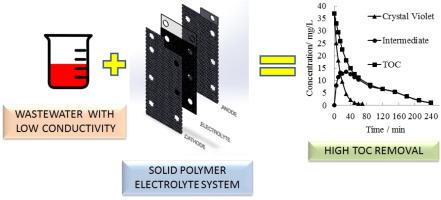Separation and Purification Technology ( IF 8.6 ) Pub Date : 2018-03-21 , DOI: 10.1016/j.seppur.2018.03.042 Nizar Klidi , Davide Clematis , Maria Paola Carpanese , Abdellatif Gadri , Salah Ammar , Marco Panizza

|
This paper explores the applicability of an innovative electrochemical cell with a solid polymer electrolyte (SPE) with mesh electrodes for the electrochemical oxidation of a low conductivity solution (0.022 mS/cm) containing crystal violet (CV) dye compound as model pollutant in a range concentration of 25–100 mg/L. The system anode/membrane/cathode is formed by Nafion membrane sandwiched between a Ti/RuO2 cathode and a BDD anode. The dependence of applied current, stirring rate, supporting electrolyte and temperature has been investigated. The experimental results showed that the electrochemical cell with SPE is suitable for the treatment of solution with a very low conductivity since the CV solution was completely mineralized with an energy consumption of about 60 kWh m−3. Furthermore, the process was under charge transfer control for low applied current, becoming mass transfer control around 1 A. The addition of supporting electrolyte as Na2SO4 (0.6 and 1 g/L) and NaHCO3 (1 g/L) to the solution decreased the removal rate due to the presence of competitive reaction and scavengers media. The evolution of nitrogen compounds during the electrolysis shows that at the end of the process the 80% of initial N has been converted in nitrate and ammonium, indicating the formation of volatile compound.
中文翻译:

使用BDD阳极与固体聚合物电解质对结晶紫进行电化学氧化
本文探讨了带有网状电极的固体聚合物电解质(SPE)的创新型电化学电池在一定范围内用于电化学氧化的低电导率溶液(0.022 mS / cm)的适用性,该溶液包含结晶紫(CV)染料化合物作为模型污染物浓度为25–100 mg / L。系统阳极/膜/阴极由夹在Ti / RuO 2阴极和BDD阳极之间的Nafion膜形成。研究了施加电流,搅拌速率,支持电解质和温度的依赖性。实验结果表明,具有SPE的电化学电池适用于处理电导率非常低的溶液,因为CV溶液已完全矿化,能耗约为60 kWh m -3。此外,该过程在低电流施加下进行电荷转移控制,变为约1 A的质量转移控制。向其中加入支持电解质,如Na 2 SO 4(0.6和1 g / L)和NaHCO 3(1 g / L)。由于存在竞争反应和清除剂介质,溶液降低了去除速率。电解过程中氮化合物的释放表明,在该过程结束时,80%的初始N已转化为硝酸盐和铵盐,表明形成了挥发性化合物。



























 京公网安备 11010802027423号
京公网安备 11010802027423号